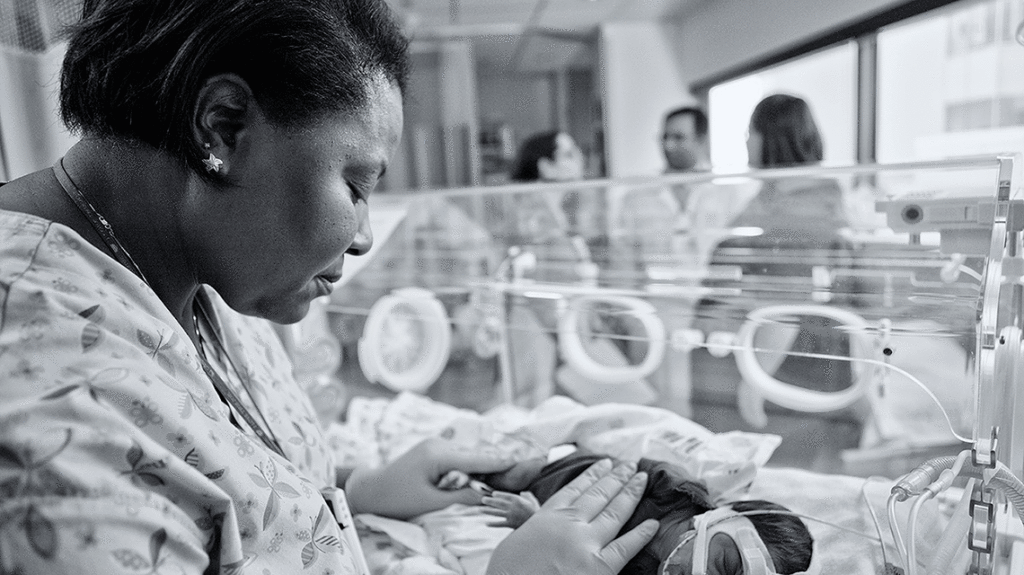Kidney Support for Babies: Building a Comprehensive and Integrated Neonatal Kidney Support Therapy Program
Kidney Support for Babies: Building a Comprehensive and Integrated Neonatal Kidney Support Therapy Program https://pediatricsnationwide.org/wp-content/uploads/2021/02/022812ds391HRBW_NICU-for-web-header-1024x575.gif 1024 575 Lauren Dembeck Lauren Dembeck https://pediatricsnationwide.org/wp-content/uploads/2021/03/Dembeck_headshot.gif- May 23, 2023
- Lauren Dembeck

Kidney support therapy (KST), commonly referred to as dialysis, is a life-saving procedure used to manage complications associated with acute kidney injury and kidney failure, such as fluid overload and electrolyte imbalances, or to remove toxins, such as those in patients with inborn errors of metabolism. Most KST or dialysis machines are designed for adults or older pediatric patients and can cause serious complications when used for infants due to the patients’ small size.
“KST therapy is offered to the most critically ill neonates,” explains Tahagod Mohamed, MD, attending in the Division of Nephrology and Hypertension at Nationwide Children’s Hospital. “However, there has been a lack of neonatal-specific devices available for these patients.”
The advent of KST devices sized for neonates and small infants is now allowing providers to achieve therapeutic goals, and hospitals to expand their neonatal intensive care unit KST programs.
A multidisciplinary team led by Dr. Mohamed and Beth Vogt, MD, medical director of the Dialysis Unit at Nationwide Children’s, recently established a state-of-the-art neonatal KST program at Nationwide Children’s and, in collaboration with other neonatal KST experts across the country, published a review article in Pediatric Nephrology describing currently available neonatal KST modalities and the steps needed to develop and sustain a neonatal KST program.
“With this publication, we hope to help other pediatric and neonatal intensive care units establish new KST programs, or for those with preexisting KST programs to implement newer modalities,” says Shina Menon, MD, medical director of Acute Renal Therapies at Seattle Children’s Hospital, who is senior author on the review article.
Neonatal KST modalities
In the review, the team describes the traditional forms of neonatal KST as well as newer KST devices, delineating the requirements and pros and cons of each form.
Traditional neonatal KST
Neonatal KST modalities include peritoneal dialysis, which uses the lining of the abdomen as a natural filter for the blood, and extracorporeal KST (either intermittent hemodialysis or continuous KST), whereby fluid and solutes are removed from or added to the patient’s blood outside the body. Traditional extracorporeal KST modalities have been associated with elevated risk of unstable blood pressure due to the large volume of the extracorporeal circuit relative to the newborn patients’ total blood volume. Thus, in infants, the most commonly used modality is peritoneal dialysis.
Newer KST devices
“In general, our colleagues have been very creative in finding ways to offer kidney support to infants,” says Dr. Mohamed.
Recently, an advanced ultrafiltration (also referred to as aquapheresis) machine originally designed for indications in adults — the Aquadex™ FlexFlow System — was adapted for use in newborns by pediatric nephrologists, David Askenazi, MD, and colleagues, at the University of Alabama. Because the process can be performed using smaller catheters and the extracorporeal volume and minimal blood flow rates are lower than with traditional devices, this ultrafiltration device is better tolerated in critically ill newborn and infant patients.
“There were no advanced KST systems available for newborns at that time,” adds Dr. Menon. “At Seattle Children’s, we started offering kidney support with the adapted machine in late 2016.”
The Aquadex™ system, was approved by the U.S. Food and Drug Administration (FDA) for use in children (>20 kg) in February of 2020, and since then, some neonatal or pediatric-specific devices have also gained FDA approval, such as the Cardio-Renal Pediatric Dialysis Emergency Machine (CARPEDIEM™) and HF20 filter.
These systems all offer continuous KST, which leads to higher clearance of waste products, lower fluid shifts, and optimal provision of nutrition and blood products while maintaining fluid balance in the infant.
Establishing a Neonatal KST Program
Few centers currently provide neonatal KST with advanced KST devices; however, their availability and use at institutions such as Nationwide and Seattle Children’s is increasing the options for care for this unique and vulnerable group of patients. With the hope of sharing knowledge and bringing more KST programs to patients in need of treatment, Dr. Mohamed and colleagues described the basic tenets for building and implementing a neonatal KST program.
The choice of neonatal KST platform(s) depends on patient characteristics, indications, goals of therapy, provider preference, and local resources. Additionally, the team points out that the ideal modality can change throughout the patients’ course.
“Our KST program has grown substantially and served some of our patients who wouldn’t have had any other opportunities for a life-saving intervention,” shares Stephanie Peters, Acute Kidney Injury APRN in the Division of Nephrology and Hypertension at Nationwide Children’s, “We are now expanding the program to include other populations, including cardiac and surgical patients.”
In the review, the team emphasizes the need for an expert multidisciplinary team with strong institutional support to establish and sustain a neonatal KST program. The neonatal KST team typically comprises pediatric nephrology providers, neonatologists, maternal-fetal medicine providers, nurse practitioners, nursing staff, surgeons, interventional radiologists, pharmacists, dietitians, and occupational and physical therapists.
“We have been fortunate to have an institution that saw the importance of this technology and its ability to improve patient outcomes and invested significant resources in it,” adds neonatologist Elizabeth Bonachea, MD, a founding member of Nationwide Children’s KST team. “As part of that, the nurses are the heart and soul of our aquapheresis program. They have been the champions of education, daily patient care, and identifying opportunities for improvement, as well as supporting the families through the process.”
Education and Training of Team Members
One of the big challenges with a KST program, explains Dr. Menon, is that the number of patients in need of KST varies, meaning sometimes no patients need the therapy.
“That is good because it means fewer sick patients,” she says. “But if you are a new program or go for months without performing a therapy, how do you ensure the team can stay competent?”
For example, during Nationwide Children’s first year of the program, the hospital administered KST to two patients; however, that number grew to over 10 the following year. At Seattle Children’s, a total of 10 newborns and infants were provided KST last year, says Dr. Menon, and they received therapy for approximately 500 days in total.
Combining this variability in patient numbers with the complexity of KST, means such programs require a comprehensive approach to educate and maintain the competency of clinicians and nurses who prescribe and manage the therapy. Thus, Dr. Mohamed and colleagues stress the need for effective initial and ongoing training and education of staff members.
While no universal education standards exist for curriculum content, methods of training, or ongoing competencies, the team suggests the use of some or all of the following components, which can be tailored for various clinicians: Four to eight hours of didactic training covering basic dialysis principles and hands-on skills training, bedside clinical coaching, just-in-time teaching, online education modules, and high-fidelity simulation.
Developing Protocols and Clinical Pathways
Dr. Mohamed and colleagues recommend that each KST program standardize its practices for the delivery of care to ensure consistent, high-quality care for all patients and across different ICUs. This includes developing, reviewing and updating policies, procedures, and guidelines, which should be easily accessible to all team members, as well as provider order-sets and nursing documentation flowsheets to be incorporated into the KST education.
“A lot of the babies who require this technology will ultimately not have a survivable disease. We are fortunate that it can absolutely save lives, but even in the cases where the outcome is not good, it can provide us time to make diagnoses and support families in making care decisions,” adds Dr. Bonachea.
Additional KST Information
In addition to the current review article, Dr. Menon and other KST experts maintain an American Society of Pediatric Nephrology (ASPN) acute care nephrology interest group, where providers can discuss program issues. They are also hoping to establish an ASPN-based educational webinar series and online repository to share protocols and clinical pathways.
Reference
Mohamed TH, Morgan J, Mottes TA, Askenazi D, Jetton JG, Menon S. Kidney support for babies: building a comprehensive and integrated neonatal kidney support therapy program. Pediatric Nephrology. 2022 Oct 13. doi: 10.1007/s00467-022-05768-y. Epub ahead of print. PMID: 36227440.
About the author
Lauren Dembeck, PhD, is a freelance science and medical writer based in New York City. She completed her BS in biology and BA in foreign languages at West Virginia University. Dr. Dembeck studied the genetic basis of natural variation in complex traits for her doctorate in genetics at North Carolina State University. She then conducted postdoctoral research on the formation and regulation of neuronal circuits at the Okinawa Institute of Science and Technology in Japan.
-
Lauren Dembeckhttps://pediatricsnationwide.org/author/lauren-dembeck/
-
Lauren Dembeckhttps://pediatricsnationwide.org/author/lauren-dembeck/
-
Lauren Dembeckhttps://pediatricsnationwide.org/author/lauren-dembeck/
-
Lauren Dembeckhttps://pediatricsnationwide.org/author/lauren-dembeck/January 29, 2019
- Posted In:
- Clinical Updates
- Features
- Research







